Collection of materials relating to neuro-ophthalmology as part of the Neuro-Ophthalmology Virtual Education Library.
NOVEL: https://novel.utah.edu/
TO
| Title | Creator | Description | Subject | ||
|---|---|---|---|---|---|
| 26 |
 |
Internuclear Ophthalmoplegia in Childhood (Guest Lecture) | Shirley H. Wray, MD, PhD, FRCP | This case was reported by Cogan DG and Wray SH. Internuclear ophthalmoplegia as an early sign of brain tumor. Neurology 1970; 20:629-633. The patient is Case 1. He is a 4 ½ year old boy whose parents noted that the right eye had been "drifting" for four months. On examination the only significant f... | Bilateral Internuclear Ophthalmoplegia; Upbeat Nystagmus; Medulloblastoma; Abducting Nystagmus |
| 27 |
 |
Pontine_Infarction | Shirley H. Wray, MD, PhD, FRCP | The patient is a 62 year old right handed man, status post myocardial infarction in 1989 and on Coumadin. In 1993 he presented with a history of three separate TIAs 1.Instantaneous perioral tingling and/or numbness lasting less than 1 minute. 2.Episodic numbness of the right hand and foot lasting le... | Unilateral Internuclear Ophthalmoplegia; Unilateral Horizontal Gaze Palsy; Upbeat Nystagmus on Upgaze; Convergence Normal; Fisher's One-and-a-Half Syndrome; Pontine Infarct; Unilateral Horizontal Gaze Palsy Infarct; Abducting Nystagmus |
| 28 |
 |
Clivus_Chordoma | Shirley H. Wray, MD, PhD, FRCP | This 46 year old patient had at age 6, a tendency for the left eye to wander out. Her face photograph at that age shows an exotropia and at age 7, a year later, the exotropia was not quite as prominent. It was assumed that the exotropia was due to a non-paralytic strabismus. Past History: At age 1 f... | Esotropia; Abduction Weakness; Sixth Nerve Palsy; Clivus Chordoma; Chordoma |
| 29 |
 |
Suprasellar Meningioma | Sumayya Almarzouqi, MD | Description of a case of suprasellar or sellar mass causeing chiasmal compression. | Suprasellar Meningioma |
| 30 |
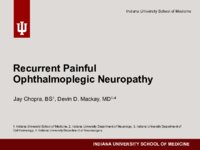 |
Recurrent Painful Ophthalmoplegic Neuropathy | Jay Chopra, BS; Devin D. Mackay, MD | Overview of recurrent painful ophthalmoplegic neuropathy with an illustrative case example and discussion of clinical presentation, possible mechanisms, and treatment. | Recurrent Painful Ophthalmoplegic Neuropathy; RPON; Ophthalmoplegic Migraine; Ophthalmoparesis; Painful Cranial Nerve Palsy |
| 31 |
 |
Whipples Disease (Guest Lecture) | Shirley H. Wray, MD, PhD, FRCP | The patient is a 44 year old woman with a past history of ethanol abuse. She was transferred to the Massachusetts General Hospital (MGH) on 3/10/93 for evaluation of memory impairment, hypothalamic dysfunction and a one month history of diplopia and ataxia. In February 1992 (13 months PTA), she deve... | Somnolence; Supranuclear Paralysis of Up and Downgaze; Vertical gaze palsy (c); Absent convergence; Pendular vergence oscillations; Bilateral lid nystagmus; Tropheryma Whippelii - Infection; CNS Whipple's Disease; Supranuclear Paralysis of Up and Downgaze Infection-Whipple's Disease |
| 32 |
 |
Pituitary Apoplexy | Nagham Al-Zubidi, MD | Patient presented with sudden vision loss left eye, horizontal binocular diplopia, sever headaches, light sensitivity and visual field defect. | Pituitary Apoplexy; Infarction or Hemorrhage of Pituitary Gland |
| 33 |
 |
Upbeat Nystagmus | Shirley H. Wray, MD, PhD, FRCP | The patient, a 36 year old Italian, presented in October 1967, at the age of 27, with acute dizziness and ataxia. He was evaluated in Rome. A pneumoencephalogram showed hydrocephalus, attributed to arachnoiditis, and a ventriculo-atrial shunt was placed. Three months post shunt placement he had a re... | Upbeat Nystagmus; Saccadic Hypermetria; Saccadic Pursuit; Square Wave Jerks; Oscillopsia; Cerebellar Astrocytoma; Primary Position Upbeat Nystagmus; Horizontal Saccadic Dysmetria |
| 34 |
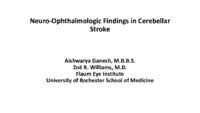 |
Neuro-ophthalmologic Findings in Cerebellar Stroke | Zoe Rebecca Williams; Aishwarya Ganesh | This PowerPoint reviews the anticipated neuro-ophthalmologic findings in cerebellar strokes including posterior inferior cerebellar artery (PICA), anterior inferior cerebellar artery (AICA) and superior cerebellar artery (SCA) territory infarcts. The review includes discussion of potential ocular mi... | AICA; Cerebellar Esotropia; Cerebellar Infarct; Lateral Medullary Syndrome; Nystagmus; Ocular Lateropulsion; PICA; SCA; Skew Deviation |
| 35 |
 |
Giant Cell Arteritis: Diagnostic Prediction Models, Temporal Artery Biopsy and Epidemiology | Edsel Ing MD, PhD FRCSC MPH CPH MIAD MEd MBA, | Giant cell arteritis (GCA) is the most common primary vasculitis in the elderly and can cause irreversible blindness, aortitis, and stroke. Diagnostic confirmation of GCA usually entails temporal artery biopsy (TABx) - a time-consuming and invasive test, or ultrasound. The primary treatment of GCA i... | Giant Cell Arteritis; Diagnostic Prediction Model; Epidemiology; Temporal Artery Biopsy; Differential Diagnosis |
| 36 |
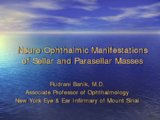 |
Neuro-Ophthalmic Manifestations of Sellar and Parasellar Masses | Rudrani Banik, MD | Neuroanatomy of the Chiasm. | Parasellar Masses |
| 37 |
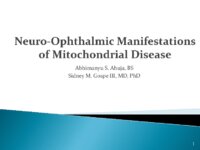 |
Neuro-Ophthalmic Manifestations of Mitochondrial Disease | Abhimanyu S. Ahuja, BS; Sidney M. Gospe III, MD, PhD | Classically, mitochondrial diseases exhibit a maternal inheritance pattern because pathogenic mutations in mitochondrial DNA (mtDNA) are transmitted exclusively via the maternal lineage due to rapid degradation of sperm-derived mitochondria early in embryogenesis. However, mutations in mtDNA may occ... | Mitochondrial Disease; Pathophysiology |
| 38 |
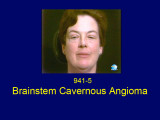 |
Brainstem Cavernous Angioma | Shirley H. Wray, MD, PhD, FRCP | The patient is a 50 year old woman who presented in November 1977 with a transient facial droop, nystagmus, diplopia, dysarthria and vertigo. She was admitted to New England Tufts Medical Center and had an extensive workup including an electroencephalogram, first generation CT brain scan, angiogram ... | Upbeat Nystagmus; Lid Nystagmus; Horizontal Gaze Evoked Nystagmus; Hiccup; Medullary Hemorrhage; Cavernous Angioma; Bilateral Lid Nystagmus; Bilateral Horizontal Gaze Palsy Hemorrhage; Primary Position Upbeat Nystagmus; Medulla Hemorrhage; Medulla |
| 39 |
 |
Diagnosis and Evaluation of Stroke in the Pons | Padmaja Sudhakar; Fatai Momodu | This short power point describes the anatomy of the pons, followed by description of stroke in the pons along with clinical presentation and work up. | Crossed Signs; One and Half Syndrome; Pontine Stroke |
| 40 |
 |
Downbeat Nystagmus | Shirley H. Wray, MD, PhD, FRCP | This 58 year old engineer was referred by his neurologist for evaluation of periodic episodes of difficulty focusing and blurred vision for 8 years. In 1981 whilst sightseeing in Newport, he became acutely aware of difficulty focusing and blurry vision. The symptoms lasted for twenty minutes and the... | Downbeat Nystagmus; Oscillopsia; Primary Position Downbeat Nystagmus |
| 41 |
 |
Intracranial Hemorrhage: Classification and Mechanisms | Victoria S. Pelak, MD | Intracranial hemorrhages can be life-threatening events. Classification of hemorrhages depends on the anatomical location, which also determines the associated risk factors for the hemorrhage. Descriptions of each type of hemorrhage and important aspects of the pathophysiology and risk factors are p... | Intracranial Hemorrhage |
| 42 |
 |
Treatment Outcomes of Ocular Manifestations in Wernicke's Encephalopathy: Images | Whitney Stuard Sambhariya PhD; Melanie Truong-Le, DO, OD | The case of a 28- year-old woman with a past medical history of gastric sleeve who was reported to have blurry vision and presented to neuro-ophthalmology with double vision. On examination the patient had bilateral abducens palsy, alternating upbeat and downbeat nystagmus with a torsional component... | Wernicke's Encephalopathy; Ocular manifestations; Neuro-ophthalmology; Sbducens palsy; Nystagmus; Double vision; Blurry vision |
| 43 |
 |
Unilateral Oculomotor Nerve Palsy Secondary to Internal Carotid Artery Aneurysm Without Pupil involvement: A Case Report | Danilo Andriatti Paulo; Richard J Blanch | Acquired oculomotor palsies (OMP) can result from numerous factors. The most common causes are presumed microvascular, trauma, compressive neoplasm, postneurosurgery and compression from aneurysm.1,2 ONP caused by internal carotid artery (ICA) aneurysm is a common clinical manifestation suggesting i... | Unilateral Oculomotor Nerve Palsy; Internal Carotid Artery Aneurysm; Pupil Involvement; Oculomotor Nerve Palsy; Secondary Oculomotor Nerve Palsy |
| 44 |
 |
Acute Idiopathic Blind Spot Enlargement (AIBSE): Case Report | Andrew R. Osborn, MD; James C. O'Brien, MD | We present a single case of Acute Idiopathic Blind Spot Enlargement (AIBSE) in a young female patient, including her clinical course and relevant imaging studies. Her case description is followed by a brief discussion surrounding the current understanding of this rare entity. Associated Images: http... | Acute Idiopathic Blind Spot Enlargement (AIBSE); Outer Retinopathy |
| 45 |
 |
Myelin Oligodendrocyte Glycoprotein Antibody Associated Disease (MOGAD) Revisited | Zahir Sheikh; Michael Gilhooley | The purpose of this presentation is to review the varied clinical manifestations of MOGAD for the neurology and neuro-ophthalmology providers. | Demyelinating; MOG; MOGAD; Myelin |
| 46 |
 |
Treatment Outcomes of Ocular Manifestations in Wernicke's Encephalopathy: Case Report | Whitney Stuard Sambhariya, PhD, Medical Student; Melanie Truong-Le, DO, OD | The case of a 28- year-old woman with a past medical history of gastric sleeve who was reported to have blurry vision and presented to neuro-ophthalmology with double vision. On examination the patient had bilateral abducens palsy, alternating upbeat and downbeat nystagmus with a torsional component... | Wernicke's Encephalopathy; Ocular Manifestations; Neuro-ophthalmology; Abducens Palsy; Nystagmus; Double Vision; Blurry Vision |
| 47 |
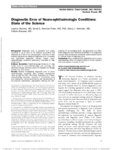 |
Diagnostic Error of Neuro-ophthalmologic Conditions: State of the Science | Leanne Stunkel, MD; David E. Newman-Toker, MD, PhD; Nancy J. Newman, MD; Valérie Biousse, MD | Diagnostic error is prevalent and costly, occurring in up to 15% of US medical encounters and affecting up to 5% of the US population. One-third of malpractice payments are related to diagnostic error. A complex and specialized diagnostic process makes neuro-ophthalmologic conditions particularly vu... | Diagnostic Errors |
